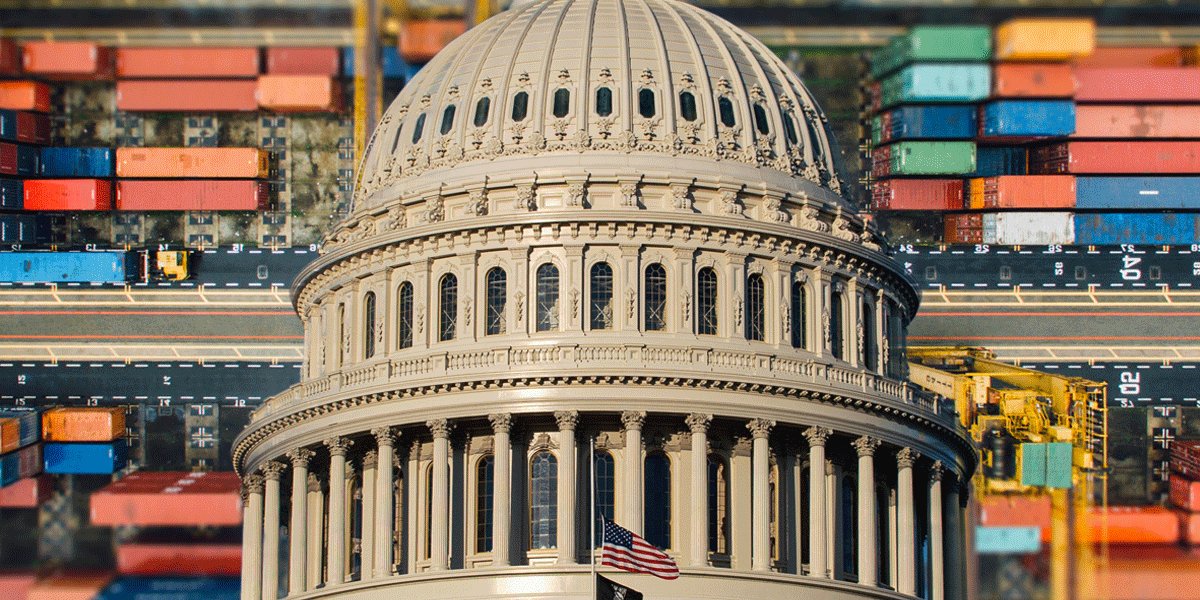Download the PDF

The changing shape of global trade in a US/China trade war
Having cowed Congress, the Judiciary, doyens of the Banking and Hedge Fund sectors, President Trump finally came up against an adversary willing to punch back: US and global financial markets. The great leveller, US equity and bond markets combined to punish excessive policy that threatens our economic system. Just as they had punished the Biden Administration’s spending program with high inflation and interest rates, markets punished President Trump’s excessive tariff policy with a one-two punch delivered by the equity market, with the KO delivered by the bond market. The Trump Administration were prepared to ride out the equity market collapse, even buoyed by the initial knee-jerk fall in bond yields. But any analyst worth their salt knew that was only a matter of time before bond markets came to their senses and refused to fund US government debt. Especially when faced with a policy destined to blow US inflation through the roof, with US Federal government indebtedness of around 100% of GDP and the US net foreign debt almost 80% of GDP.
“What about the funds raised by the tariffs?”, you may ask. “Aren’t they meant to help replenish the government coffers?” They are, but when your tariffs reduce imports to zero, you don’t collect tariff revenue no matter how high the tariff rate is set. So, faced with an adversary with spine, President Trump was forced to capitulate. But not entirely. If there were ever any doubt who the prime villain is in Trump world, that doubt should now be extinguished. China is the mortal enemy. And as the tariff war between the two escalates and approaches a zero-trade outcome, equity and bond markets are once again loading up to deliver another knockout blow. As the Trump Administration ratchets up tariffs on Chinese imports to 125% 145% and China retaliates with an 84% increase of their own against US imports, equity and bond prices are once again on the way down. So, what does a world of no trade between the US and China look like? Grim, is the short answer. The US would undoubtedly lapse into recession as inflation and interest rates rise. Further downside to equity markets compounds the problems facing the US economy. China would be facing an unparalleled challenge for the post-Mao era and a recession with negative growth rates (almost unheard of for China) would be on the table. Chinese authorities would be forced to act with fiscal and monetary stimulus, stretching the resources of the Chinese economy and causing China to scramble for alternative export markets.
A key impact on the global economic landscape would be the ensuing redirection of US and China trade flows. What does the new order look like? The trade flows are very large, China sells around US$500 billion of exports to the US, and the US sells around US$150 billion to China, but these flows need to be placed into context. Together, trade between US and China accounts for about 3% of global trade, a seemingly modest percentage. But another way of looking at the problem is that China’s trading partners would have to increase their demand for imports from China by around 17% to absorb Chinese exports redirected from the US; quite a challenge. In contrast, they would need to increase their demand for imports from the US by only 8% to absorb US exports redirected from China. Who would be the key customers? Outside the US, China’s biggest customers by region are East Asia (~US$1 trillion or 30% of China’s exports) and the EU (~US$500 billion or 14% of China’s exports).
Even if we convince ourselves that the rest of the world can, in an absolute sense, absorb the diverted trade flows, will the goods that are being diverted be those that the rest of the world wants? China will be looking to sell about US$125 billion of Electrical Machinery, US$89 billion of Heavy Machinery and US$29 billion of Toys, Games and Sports (Leisure), with these among their top goods categories. The EU and East Asia are large consumers of the first two categories and could conceivably increase their demand to absorb the excess supply redirected from the US without significant disruption. The required increase in demand would be 16% to 20% depending on the product category.
However, the third major category of Leisure would require an approximate 50% jump in demand. For this category, it is likely that if China were to redirect exports it would severely depress prices in the EU and East Asia and, depending on the degree of competitive threat it poses to domestic industries, could be met with anti-dumping measures. From China’s perspective, it too can replace imports of US manufactured goods with imports from the EU and East Asia. However, its imports of US Mineral Fuels cannot be easily replaced by these two regions. To compensate for the loss of US Mineral Fuels imports, it is likely that China will lean more heavily on its dominant supplier – Russia.
Although Australia is small fry, we take just US$74 billion from China, or about 2% of China’s total exports, the implications for our economy of diverted trade flows is significant. If we were to absorb “our share”, we would need to boost our intake of all goods by $15 billion, an increase of 20%, with a large share taken by the Electrical & Heavy Machinery and the Leisure categories. The good news is that Australia does not have industries competing with these imports, so we can benefit from lower prices of goods that serve consumers and businesses through capital expenditure. In addition, Australia exports US$9 billion of food products and US$23 billion of Mineral Fuels to China and we can expect a boost to these exports to help replace the lost imports of these goods from the US.
In summary, a tariff war between the US and China will create significant downside to their respective economies, forcing both into recession in the absence of significant stimulus. It is also likely to push the EU, East Asia, Russia and China closer together through a redirection of trade flows – counter to the Trump Administration’s goal of isolating China. Australia is a likely beneficiary of redirected trade flows from two sources: (i) cheap manufactured imports from China, and (ii) increased demand for our Oil & Mineral Fuel and Agricultural exports.

